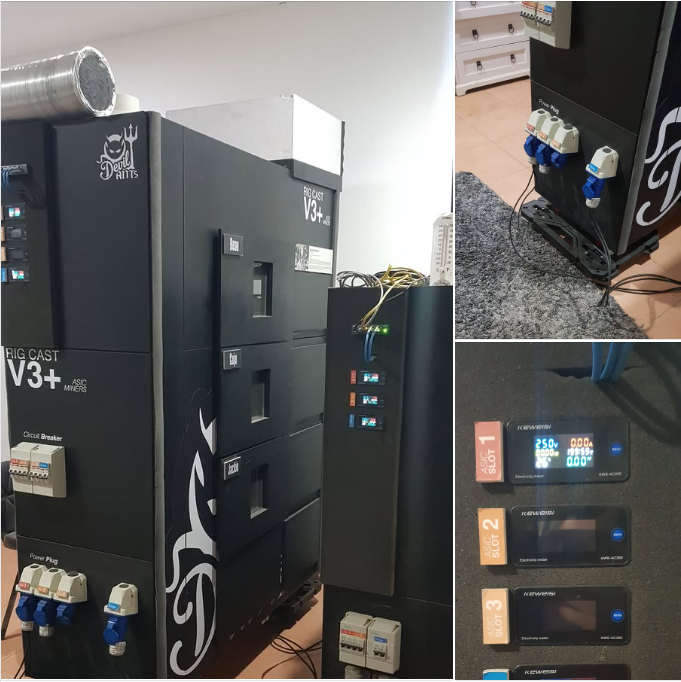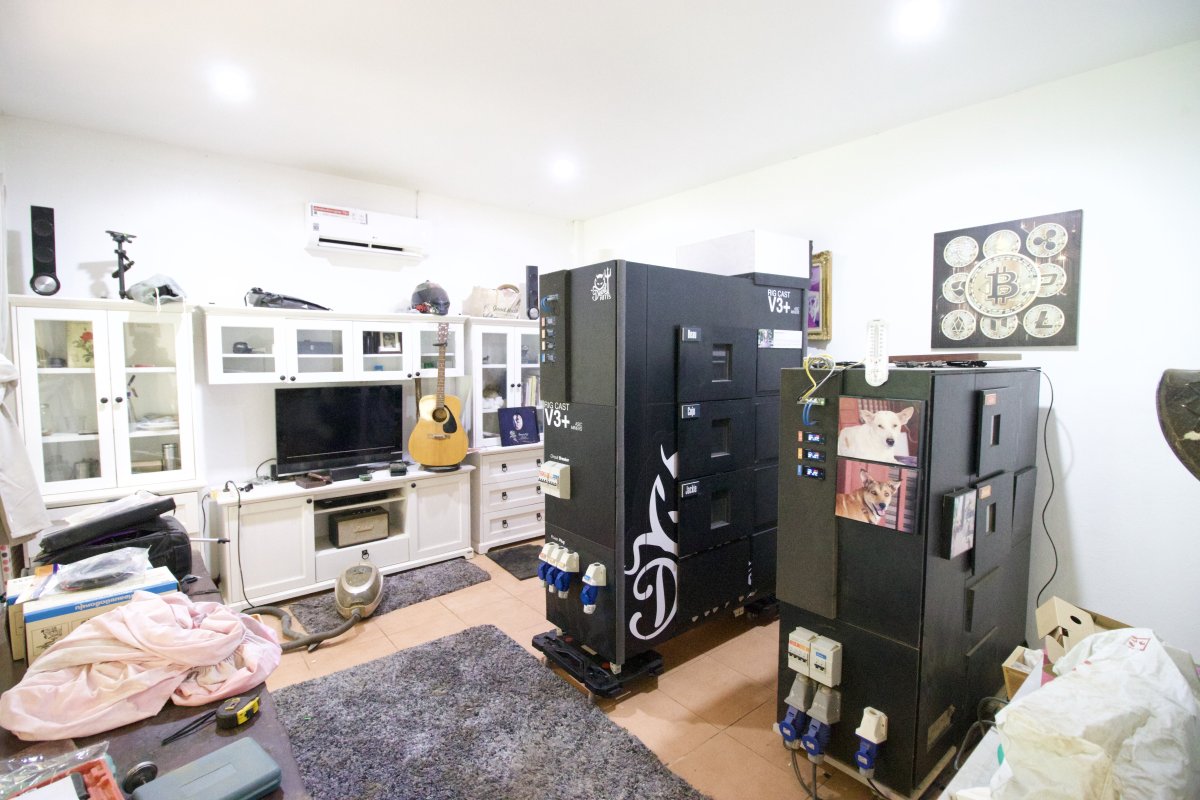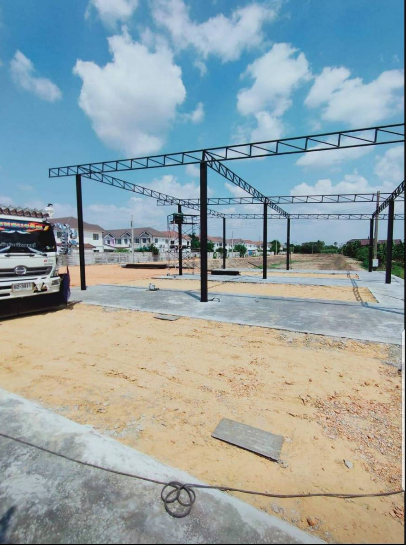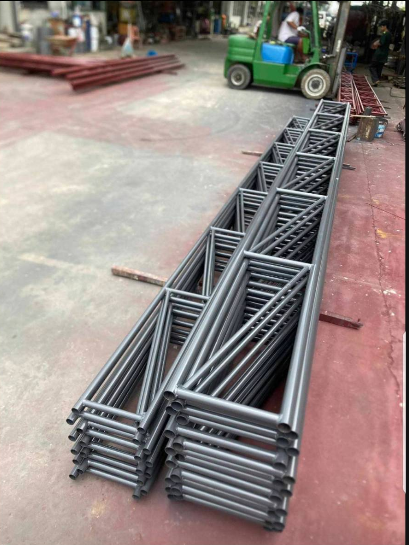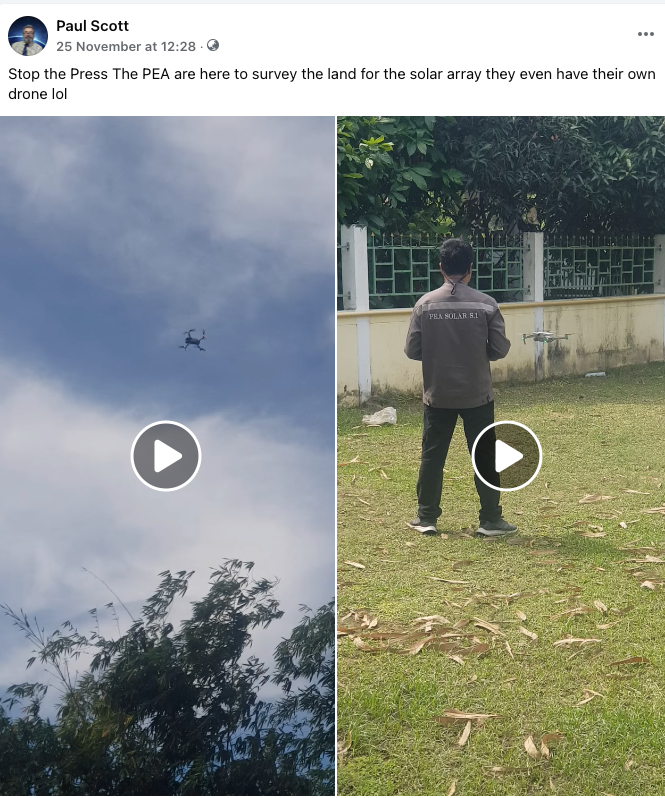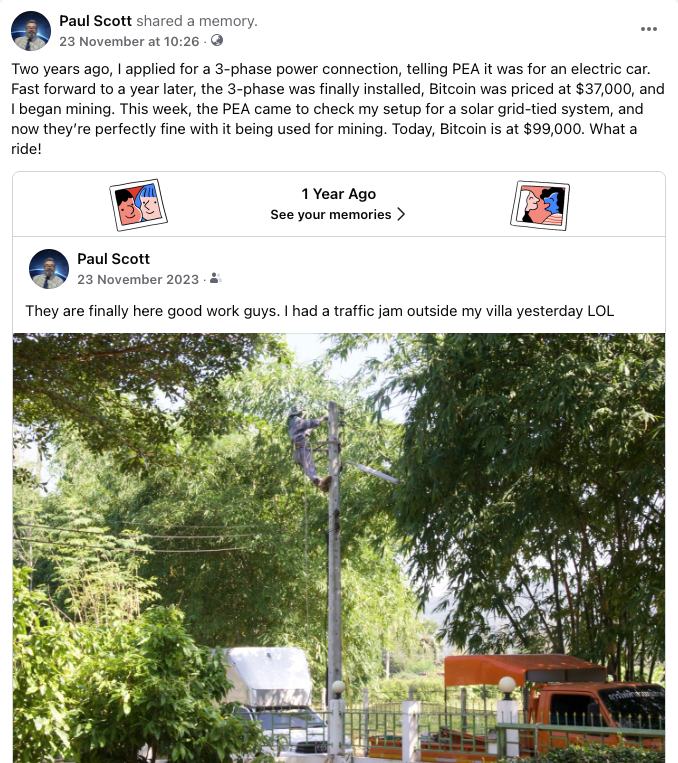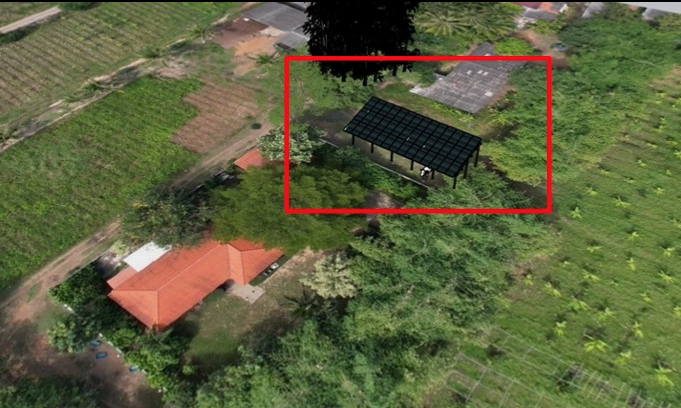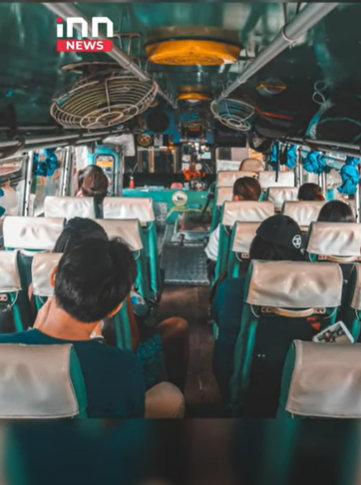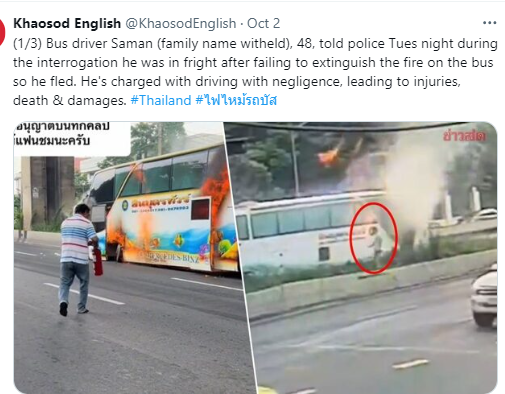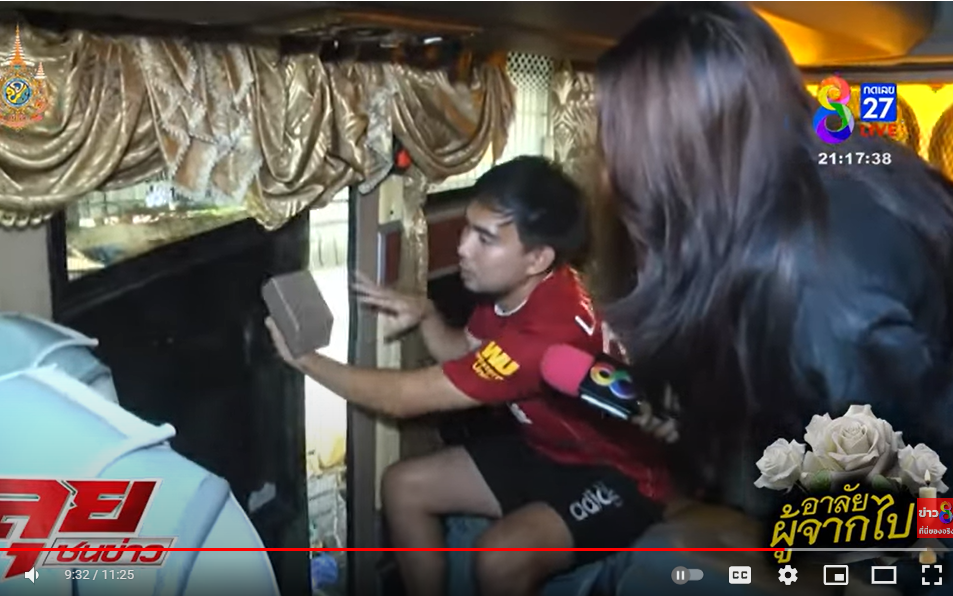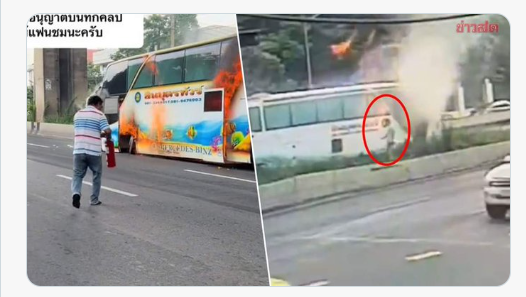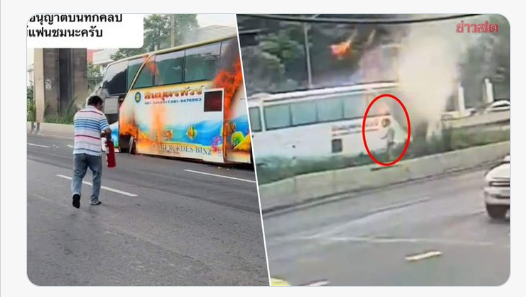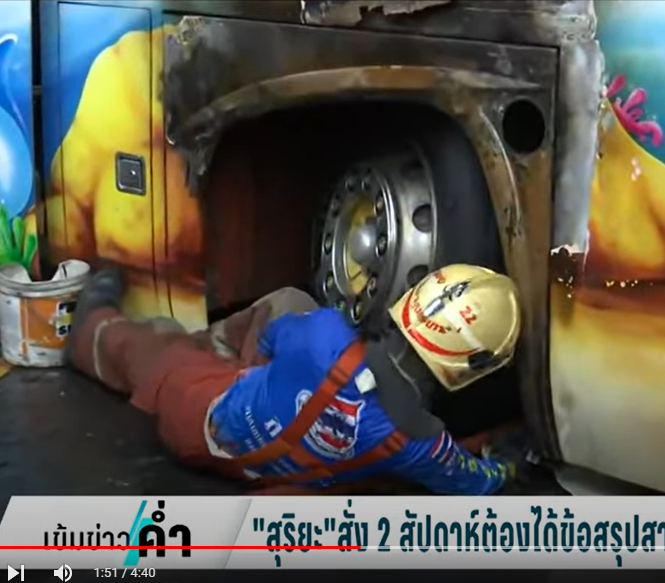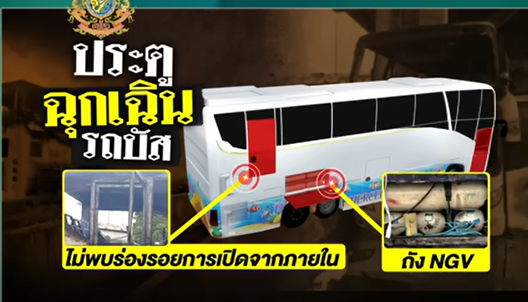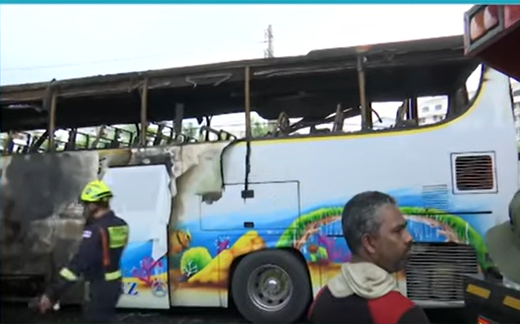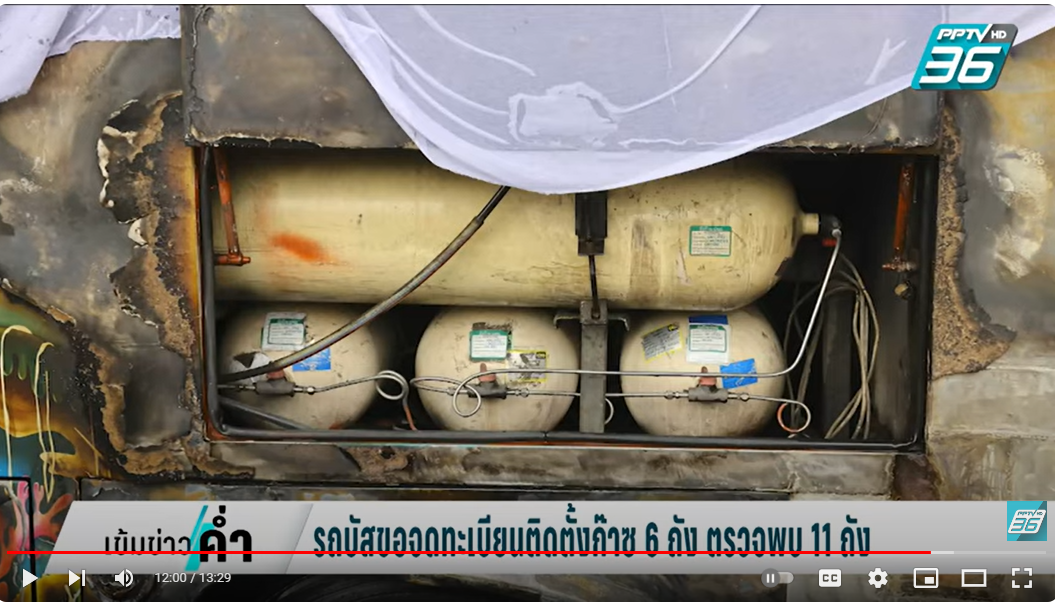-
Posts
510 -
Joined
-
Last visited
Content Type
Events
Forums
Downloads
Quizzes
Gallery
Blogs
Everything posted by scott1999
-
Yesterday the electrician promised to connect the new soundproof box for the new miners to my system but he didn't come and didn't answer my messages so I did it myself. It is working ok, I could have blown myself up, but I was so angry that I took the day off, just for him not to show up. This is one of the downsides of living in Thailand, but the advantages outweigh the disadvantages by a long way.
-
Today is a big day. The electrician is coming to plumb in the bigger new soundbox Stage 1 is now completed. On to stage 2 as explained in my Facebook post They are ASIC miners that mine Bitcoin. Stage 1: We were to get 3-phase electricity because if you don't have three-phase, you could run one miner off a standard home set-up only. But with three-phase and the correct transformer you can run 10 miners. Stage 2: Running at half capacity for 2025. Stage 3: 2026 will be running at full capacity which will need the solar system to help pay for the electricity. It's not just about the money it's just another way to escape the matrix no banks no inflation, no worries. LOL this is another reason I love Thailand can you imagine me trying to do this in a residential estate in England my God they would lock me up LOL Are we getting it yet? I'm proud to be part of this network they are stealing our time and energy with inflation for me not anymore. https://x.com/i/status/1875236330755822025
-
Update: PEA Will help with the structure of the canopy before their workmen come to install the system, added bonus they will put the system in before I even pay the deposit of 50%. I think I read the message wrong I think I can pay after the canopy structure has been built it's okay nice of them to help
-

Abduction Of My Daughter, By My Thai Wife
scott1999 replied to scott1999's topic in Family and Children
-

Abduction Of My Daughter, By My Thai Wife
scott1999 replied to scott1999's topic in Family and Children
Thank you, my friend. My Daughter is coming to stay with me this Christmas thank you everyone that contributed with my situation I talk to my daughter most days now, she lives in England and I live near Hua Hin. Thank you Thaivisa for keeping this thread alive -
Hi, Wombat you guessed wrong my friend. Sorry, I've been busy as you can see. Quick update. PEA has given me a quote for a 20 kW grid-tied system with no batteries 420,000 Half upfront the rest can be on finance I think I will pull the trigger because that is my dream come true. I really need a bigger system but beggars can't be choosers. My electricity bill is excessive now so this must be done. PEA were and are super nice people very professional very high level of education and most can speak very good English better than my Thai LOL
-

Bus Owner Caught Trying to Hide Illegal Gas Cylinders After Deadly Fire
scott1999 replied to webfact's topic in Thailand News
I'm not going to argue on this forum as it's just completely a waste of time. I was in this business in England for over 20 years the duty of the driver is the care and safety of the passengers this could have been dealt with very differently if the driver had stopped the bus turned off the engine turned round and said three words get off now and he had helped them leave the bus He would be a hero today. Instead he went looking for a fire extinguisher and trying to open the back Emergency doors that he should have checked before any passengers got on the vehicle. Obviously the bus was badly maintained it had been turned into a bomb with 11 gas cylinders with one of the cylinders in the passenger section of the bus a company that has form of their driver's running away in the past and now it looks like the Ministry of transport officers were getting kickbacks to certify these busses death traps so as I was saying 1: The drivers only job in an emergency is the safety of the passengers not to try and put out a fire he can do that afterwards once all the passengers have left the bus and don't say they couldn't get off because of the doors and even in that video there's a student that got out of the door there was half open. And as for the state of the interiors of these Thai busses they've turned them into bombs on wheels with everything inside flammable such as the curtains the plastic fans the seat covers as you can see from the photos of the bus the whole interior was gutted now look at a bus in England no curtains no padding on the ceilings no fans just clean and safe they need to stop turning these vehicles into mobile discos and understand their only responsibility is to get their passengers from A to B as safely as possible. Here's a list of the duty of care that each driver should be trained to understand and do in an emergency which of course this driver didn't do. In the event of a fire, your top priority as a bus or coach driver is to help passengers disembark as quickly and safely as possible before the fire escalates. Here's how the procedure should go: Stop the vehicle safely: Pull over immediately and turn off the engine to reduce any additional risk of the fire spreading. Open the doors: Immediately open the doors to allow passengers to disembark and leave the vehicle quickly. Instruct passengers: Calmly but firmly instruct passengers to exit the bus in an orderly manner. Encourage them to leave personal belongings behind to speed up the evacuation. Use emergency exits: If the main doors are blocked or unsafe, direct passengers to use emergency exits, including windows or roof hatches. Move passengers to a safe distance: Once outside, guide everyone to a safe distance, away from the vehicle and out of harm’s way. Call emergency services: After ensuring all passengers are safe, contact emergency services to report the fire and get help. Once everyone is safely off the vehicle, then, if it’s safe and you are trained, you can attempt to control the fire with a fire extinguisher. However, passenger safety is always the first priority. -

Four Charges Filed Against Driver in Bus Fire That Killed 23
scott1999 replied to webfact's topic in Thailand News
All their busses had uncertified gass tanks on their busses as this article proves I would expect the operator to do prison time for this From the article However, the Shinbutra Company failed to send the five other buses for inspection at the Lopburi Provincial Transport Department; instead, they went directly to an auto shop in Nakhon Ratchasima Province.... อ่านข่าวต้นฉบับได้ที่ : https://www.khaosodenglish.com/news/2024/10/03/fatal-bus-fire-probe-exposes-thai-officials-and-company-fraud-claims/?fbclid=IwY2xjawFrjI9leHRuA2FlbQIxMQABHbRilX5bY8034nce_60Hs71LFcbLYExpu56AIeUmesI6LFDEpykP6qKaRA_aem_XyFW_tVT9uZolG8xJlNcdQ Where they had the uncertified tanks removed This is a step in the right direction The new regulations require chartered buses to have staff on board, similar to regular public buses. These employees must be trained and complete a course on crisis management My ex girlfriend works for the Ministry of labor labor informed that there was four minutes before the bus was engulfed with flames any Driver following procedure would have had those passengers off that bus in less than two minutes. -

Four Charges Filed Against Driver in Bus Fire That Killed 23
scott1999 replied to webfact's topic in Thailand News
The driver would have been a hero if he'd followed procedure That photo that I've posted is one of the saddest I've ever seen he's walking towards the bus that is engulfed with fire too late the children are probably already dead he should never have left that bus he could have got them out even through the smallest hole because he got out In the event of a fire, your top priority as a bus or coach driver is to help passengers disembark as quickly and safely as possible before the fire escalates. Here's how the procedure should go: Stop the vehicle safely: Pull over immediately and turn off the engine to reduce any additional risk of the fire spreading. Open the doors: Immediately open the doors to allow passengers to disembark and leave the vehicle quickly. Instruct passengers: Calmly but firmly instruct passengers to exit the bus in an orderly manner. Encourage them to leave personal belongings behind to speed up the evacuation. Use emergency exits: If the main doors are blocked or unsafe, direct passengers to use emergency exits, including windows or roof hatches. Move passengers to a safe distance: Once outside, guide everyone to a safe distance, away from the vehicle and out of harm’s way. Call emergency services: After ensuring all passengers are safe, contact emergency services to report the fire and get help. Once everyone is safely off the vehicle, then, if it’s safe and you are trained, you can attempt to control the fire with a fire extinguisher. However, passenger safety is always the first priority. -

Four Charges Filed Against Driver in Bus Fire That Killed 23
scott1999 replied to webfact's topic in Thailand News
I had an operator's license in England for over 20 years without one death on my conscience so I do know a thing or two/ Yesterday when I was posting we didn't know the full facts we still don't know all of them now but we know a lot more. This afternoon I spoke to my ex girlfriend who works for the Ministry of Labor and they were informed that they had 4 minutes before the bus was engulfed with fire I tried to explain to her you only needed one or two minutes to get all the passengers off that bus safely. In my opinion now every death was avoidable, accidents happen to new busses either it's their fault or it's the car in front or it's the road or it's the weather it can be anything it's what you do once you've brought the vehicle to a stop it's those precious seconds that can save lives. In the event of a fire, your top priority as a bus or coach driver is to help passengers disembark as quickly and safely as possible before the fire escalates. Here's how the procedure should go: Stop the vehicle safely: Pull over immediately and turn off the engine to reduce any additional risk of the fire spreading. Open the doors: Immediately open the doors to allow passengers to disembark and leave the vehicle quickly. Instruct passengers: Calmly but firmly instruct passengers to exit the bus in an orderly manner. Encourage them to leave personal belongings behind to speed up the evacuation. Use emergency exits: If the main doors are blocked or unsafe, direct passengers to use emergency exits, including windows or roof hatches. Move passengers to a safe distance: Once outside, guide everyone to a safe distance, away from the vehicle and out of harm’s way. Call emergency services: After ensuring all passengers are safe, contact emergency services to report the fire and get help. Once everyone is safely off the vehicle, then, if it’s safe and you are trained, you can attempt to control the fire with a fire extinguisher. However, passenger safety is always the first priority. Like I said how many children could he have saved if he had done it properly and not jumped off the bus to save himself plus, And for God's sake get rid of all the curtains plastic fans, and ornaments that are just fire traps that they deck out these coaches with In the second picture there's the driver with a fire extinguisher the children are still on the bus it should be passengers off the bus first then you can try and deal with the fire if you want to he did it the wrong way around this is one of the saddest pictures i've ever seen -

Four Charges Filed Against Driver in Bus Fire That Killed 23
scott1999 replied to webfact's topic in Thailand News
I agree Thailand is a magnificent country with lovely people and the laws are more relaxed. But if you're telling me there should be no rules or laws or safety checks or training to carry 50 plus children and teachers then I will have to disagree with you good luck on your next bus ride. We are but guests in their beautiful country -

Four Charges Filed Against Driver in Bus Fire That Killed 23
scott1999 replied to webfact's topic in Thailand News
And there you have it the passengers were still on the bus and the driver was looking for a fire extinguisher but was never going to put the fire out if he had done it properly and got the passengers off the bus as soon as there was a problem I'm guessing there would have been no fatalities -

Four Charges Filed Against Driver in Bus Fire That Killed 23
scott1999 replied to webfact's topic in Thailand News
Well this looks suspiciously like a blowout but as I said it was a moving bomb anything could have set it off -

Four Charges Filed Against Driver in Bus Fire That Killed 23
scott1999 replied to webfact's topic in Thailand News
I can't speak Thai but I have been following the news they have video footage of the driver running to the next bus to try and get a fire extinguisher if he'd done as he was supposed to which was get all the passengers off the bus first They possibly could have been no fatalities who knows As I said in my very first post a lot of money was spent on the cartoon character respray and nothing on the safety or training of the driver look at that emergency door very close to the tanks wonderful great planning to me it just looks like a bomb Again here is the procedure of what a driver should do in the instance of a fire In the event of a fire, your top priority as a bus or coach driver is to help passengers disembark as quickly and safely as possible before the fire escalates. Here's how the procedure should go: Stop the vehicle safely: Pull over immediately and turn off the engine to reduce any additional risk of the fire spreading. Open the doors: Immediately open the doors to allow passengers to disembark and leave the vehicle quickly. Instruct passengers: Calmly but firmly instruct passengers to exit the bus in an orderly manner. Encourage them to leave personal belongings behind to speed up the evacuation. Use emergency exits: If the main doors are blocked or unsafe, direct passengers to use emergency exits, including windows or roof hatches. Move passengers to a safe distance: Once outside, guide everyone to a safe distance, away from the vehicle and out of harm’s way. Call emergency services: After ensuring all passengers are safe, contact emergency services to report the fire and get help. Once everyone is safely off the vehicle, then, if it’s safe and you are trained, you can attempt to control the fire with a fire extinguisher. However, passenger safety is always the first priority. -

Four Charges Filed Against Driver in Bus Fire That Killed 23
scott1999 replied to webfact's topic in Thailand News
Chat GPS says CNG is safer than Petrol or diesel. It could have been something as unlucky as part of the tyre that exploded went on to the exhaust which then burst into flames which then the floor of the bus could be made of wood and as I've said in previous posts with the paraphernalia they have in these busses even the padding in the ceiling is ridiculous once it gets hold there's gonna be no stopping it I don't usually come onto Thai visa but this affected me so much today those poor children there was no one there to save them I May have nightmares over this. Buses using Compressed Natural Gas (CNG) as fuel are designed with stringent safety measures to minimize the risk of accidents causing fuel line ruptures and fires. However, in the event of a severe accident, there is still a potential for danger, though an instant fire is less likely compared to other fuels like gasoline or diesel. Here's why: 1. Fuel Line Integrity and Safety CNG Fuel Tanks: CNG buses have high-pressure tanks made of durable materials, such as steel or composite, designed to withstand impacts and extreme conditions. These tanks are rigorously tested to prevent ruptures during accidents. Shutoff Valves: Modern CNG systems are equipped with automatic shutoff valves that are triggered by a significant impact or pressure drop, cutting off the fuel supply to prevent leakage. Pressure Relief Devices (PRDs): These devices help safely vent gas in case of excessive pressure buildup, reducing the chance of explosion or fire. 2. CNG vs. Liquid Fuels Lower Flammability: CNG is less flammable than gasoline or diesel because it has a narrow flammability range and requires a higher ignition temperature. The gas also dissipates rapidly into the atmosphere because it is lighter than air, reducing the risk of fire if released. No Liquid Pooling: Unlike liquid fuels that can pool and ignite quickly, CNG is in gaseous form, meaning it disperses quickly into the air, making an instant fire less likely in the event of a leak. 3. Accident Scenarios Minor to Moderate Accident: In many cases, the automatic shutoff valves and PRDs will prevent a rupture or any significant gas release. Severe Accident: In a severe impact that damages both the CNG fuel tanks and safety systems, there could be a risk of gas escaping. However, due to the nature of CNG (lighter-than-air gas and higher ignition point), an instant fire or explosion is less likely unless the gas comes into contact with a direct ignition source (e.g., sparks, flames). Conclusion: While any fuel system can present hazards in an accident, CNG-powered buses are designed with safety features to prevent fuel line ruptures and instant fires. The likelihood of a fire or explosion from CNG in an accident is significantly lower than with conventional fuels, but the risk is not entirely eliminated. 4o -

Four Charges Filed Against Driver in Bus Fire That Killed 23
scott1999 replied to webfact's topic in Thailand News
It was the driver's duty to take care of those passengers I am flabbergasted at what has transpired we now find out that there were bodies huddled near the Emergency exit door to me that means it was locked so not only did the driver not follow procedure and get the children off the bus before trying to put out the fire he ran away with the emergency exit door locked he has to live with this for the rest of his life which I don't think will be very long how can you live with this on your conscience. -

Four Charges Filed Against Driver in Bus Fire That Killed 23
scott1999 replied to webfact's topic in Thailand News
In the event of a fire, your top priority as a bus or coach driver is to help passengers disembark as quickly and safely as possible before the fire escalates. Here's how the procedure should go: Stop the vehicle safely: Pull over immediately and turn off the engine to reduce any additional risk of the fire spreading. Open the doors: Immediately open the doors to allow passengers to disembark and leave the vehicle quickly. Instruct passengers: Calmly but firmly instruct passengers to exit the bus in an orderly manner. Encourage them to leave personal belongings behind to speed up the evacuation. Use emergency exits: If the main doors are blocked or unsafe, direct passengers to use emergency exits, including windows or roof hatches. Move passengers to a safe distance: Once outside, guide everyone to a safe distance, away from the vehicle and out of harm’s way. Call emergency services: After ensuring all passengers are safe, contact emergency services to report the fire and get help. Once everyone is safely off the vehicle, then, if it’s safe and you are trained, you can attempt to control the fire with a fire extinguisher. However, passenger safety is always the first priority. -

Four Charges Filed Against Driver in Bus Fire That Killed 23
scott1999 replied to webfact's topic in Thailand News
Good question when I had my operators license this was the procedure. You usually have to sign a contract with a reputable garage that will take care of all the maintenance records As for the drivers they have to pass their PCV test which will include safety procedures it's not hard to do this has gone on too long thailand all that crap that they put on those coaches the electric fans the padding in the ceiling with the stupid lights the flags it's just Death trap if there was to be a fire In England, the maintenance schedule for a bus follows a structured plan as mandated by the Driver and Vehicle Standards Agency (DVSA) and other regulatory bodies. The specific schedule can vary depending on the type of bus, its age, usage, and the operating environment. However, typical components of a maintenance schedule include the following: 1. Daily Checks Driver Walkaround Checks: Every bus driver is required to perform a daily walkaround check before taking the vehicle out. This typically includes: Checking lights, indicators, and reflectors. Ensuring tires are in good condition. Verifying fluid levels (oil, coolant, windshield washer fluid). Checking mirrors, wipers, and seat belts. Ensuring doors, windows, and emergency exits function correctly. Checking the horn, steering, and brakes. Defect Reporting: Any defects found during daily checks must be reported and addressed before the bus can be used. 2. Weekly or Biweekly Checks These may involve deeper checks on: Brake wear and performance. Air pressure systems (for buses with air brakes). More detailed fluid level checks (e.g., power steering fluid). Battery charge and condition. 3. Six-Week or Monthly Inspections Routine Maintenance: Buses are generally subject to more comprehensive mechanical inspections every four to six weeks, depending on the intensity of their use. These inspections can include: Checking the entire braking system. Inspecting the suspension system. Ensuring the exhaust system is functioning correctly. Checking for corrosion or damage to the chassis. More detailed engine diagnostics. Record Keeping: Maintenance records must be kept for each inspection and repair, in compliance with regulations. 4. Annual MOT Test Public Service Vehicle Test: All buses must pass an annual MOT (Ministry of Transport) test to ensure roadworthiness. This is more stringent than a standard car MOT and covers: Structural integrity and safety features. Emissions testing. Exhaust, fuel systems, and general mechanical checks. Brake testing and performance analysis. 5. Mileage-Based Servicing In addition to time-based schedules, buses may be serviced based on the distance traveled. For example, a bus might require oil changes, air filter replacements, and brake inspections after reaching a certain mileage threshold (e.g., every 10,000-12,000 miles). 6. Seasonal Maintenance Winter Preparation: Preparing buses for cold weather includes checking heating systems, antifreeze levels, and tire tread depth to handle wet or icy conditions. Summer Preparation: Ensuring air conditioning systems and cooling systems are working efficiently. 7. Ad-Hoc Repairs If a fault is detected during operation, the vehicle must undergo repair immediately to ensure it meets safety standards before being used again. 8. Adherence to Operator’s License Requirements Bus operators must adhere to the terms of their O-Licence (Operator’s License), which includes maintaining a regular service schedule for the buses in their fleet. Maintaining these standards is crucial not only for regulatory compliance but also for ensuring passenger safety and the longevity of the vehicle. -

Four Charges Filed Against Driver in Bus Fire That Killed 23
scott1999 replied to webfact's topic in Thailand News
I couldn't agree more so now it looks like the rear exit door wouldn't open which is the first thing the driver should check before he picks up any passengers I've laid out what the procedure is in an emergency of which I've had a few seen as I had a operator's license for over 20 years this could have been avoided or as you say many more saved and for idiots on here to pontificate about the driver trying to put out the fire twice is just a ridiculous uneducated cowardly comment In the event of a fire, your top priority as a bus or coach driver is to help passengers disembark as quickly and safely as possible before the fire escalates. Here's how the procedure should go: Stop the vehicle safely: Pull over immediately and turn off the engine to reduce any additional risk of the fire spreading. Open the doors: Immediately open the doors to allow passengers to disembark and leave the vehicle quickly. Instruct passengers: Calmly but firmly instruct passengers to exit the bus in an orderly manner. Encourage them to leave personal belongings behind to speed up the evacuation. Use emergency exits: If the main doors are blocked or unsafe, direct passengers to use emergency exits, including windows or roof hatches. Move passengers to a safe distance: Once outside, guide everyone to a safe distance, away from the vehicle and out of harm’s way. Call emergency services: After ensuring all passengers are safe, contact emergency services to report the fire and get help. Once everyone is safely off the vehicle, then, if it’s safe and you are trained, you can attempt to control the fire with a fire extinguisher. However, passenger safety is always the first priority. 4o -

Four Charges Filed Against Driver in Bus Fire That Killed 23
scott1999 replied to webfact's topic in Thailand News
No, you are stupid, (to enter) He should have followed procedure. Tippy tapping on your computer not knowing What you are talking about makes you Stupid In the event of a fire, your top priority as a bus or coach driver is to help passengers disembark as quickly and safely as possible before the fire escalates. Here's how the procedure should go: Stop the vehicle safely: Pull over immediately and turn off the engine to reduce any additional risk of the fire spreading. Open the doors: Immediately open the doors to allow passengers to disembark and leave the vehicle quickly. Instruct passengers: Calmly but firmly instruct passengers to exit the bus in an orderly manner. Encourage them to leave personal belongings behind to speed up the evacuation. Use emergency exits: If the main doors are blocked or unsafe, direct passengers to use emergency exits, including windows or roof hatches. Move passengers to a safe distance: Once outside, guide everyone to a safe distance, away from the vehicle and out of harm’s way. Call emergency services: After ensuring all passengers are safe, contact emergency services to report the fire and get help. Once everyone is safely off the vehicle, then, if it’s safe and you are trained, you can attempt to control the fire with a fire extinguisher. However, passenger safety is always the first priority. 4o -

Four Charges Filed Against Driver in Bus Fire That Killed 23
scott1999 replied to webfact's topic in Thailand News
In the event of a fire, your top priority as a bus or coach driver is to help passengers disembark as quickly and safely as possible before the fire escalates. Here's how the procedure should go: Stop the vehicle safely: Pull over immediately and turn off the engine to reduce any additional risk of the fire spreading. Open the doors: Immediately open the doors to allow passengers to disembark and leave the vehicle quickly. Instruct passengers: Calmly but firmly instruct passengers to exit the bus in an orderly manner. Encourage them to leave personal belongings behind to speed up the evacuation. Use emergency exits: If the main doors are blocked or unsafe, direct passengers to use emergency exits, including windows or roof hatches. Move passengers to a safe distance: Once outside, guide everyone to a safe distance, away from the vehicle and out of harm’s way. Call emergency services: After ensuring all passengers are safe, contact emergency services to report the fire and get help. Once everyone is safely off the vehicle, then, if it’s safe and you are trained, you can attempt to control the fire with a fire extinguisher. However, passenger safety is always the first priority. Like I said how many children could he have saved if he had done it properly and not jumped off the bus to save himself 4o -

Four Charges Filed Against Driver in Bus Fire That Killed 23
scott1999 replied to webfact's topic in Thailand News
You say He got out to try and extinguish the fire twice, so your saying he should have just stayed on the bus without trying to put the fire out................. And how many children could he have saved instead of trying to put the fire out (Twice) which was unsuccessful anyway that's not the procedure the procedure is to get the passengers off the vehicle as fast as you can but what do I know I only had an operator's license for 20 years You just keep Tippy tapping on you computer idiot There are so many things in play here the condition of the vehicle the training to the driver the age of the vehicle of course but you do not leave passengers on the vehicle and get off the vehicle yourself. Nice to know what you would do if you were the driver -

Four Charges Filed Against Driver in Bus Fire That Killed 23
scott1999 replied to webfact's topic in Thailand News
brianthainess Stupid statement IMO to enter an inferno like that would be impossible, your face would be burnt off at the door, even if you could get that close. brianthainess No, your comment is stupid (the driver should not be entering the bus) The driver should never have left the bus until all the passengers had got out, IMO -

Four Charges Filed Against Driver in Bus Fire That Killed 23
scott1999 replied to webfact's topic in Thailand News
You are right of course when I first came to Thailand I would say stupid things like it's not like this in England well this Isn't England. Thank you for reminding me.


